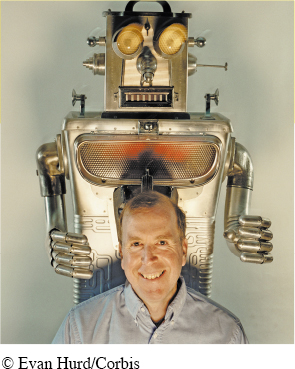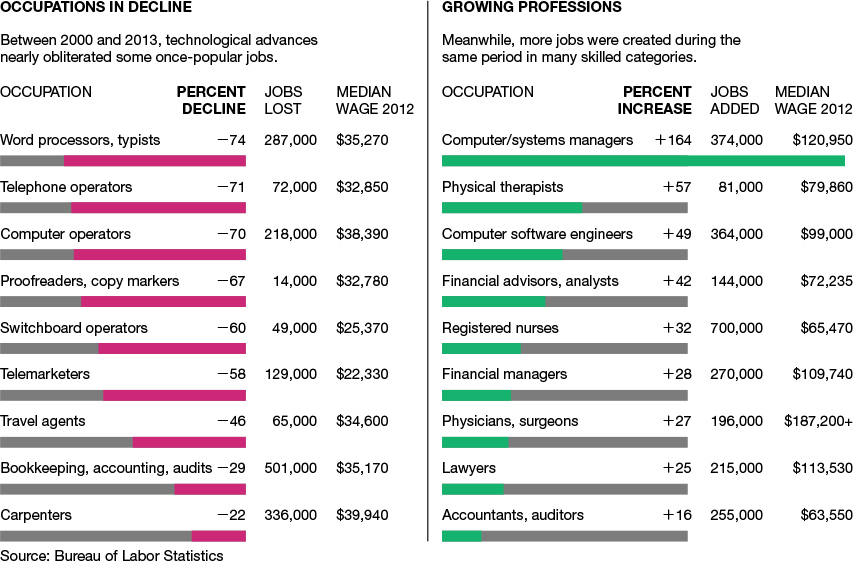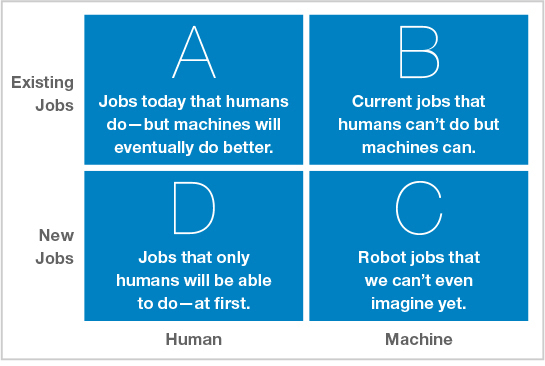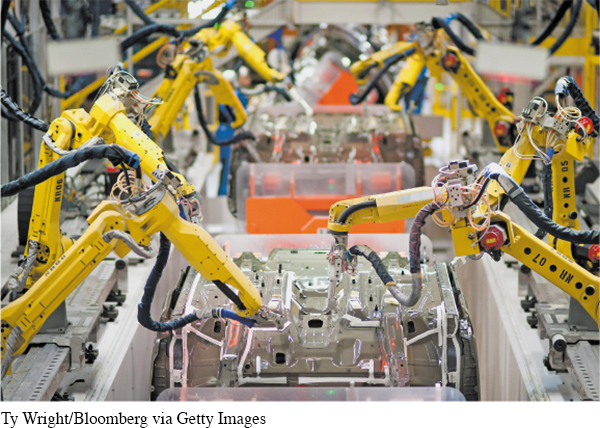10.15
from Better Than Human: Why Robots Will—
Kevin Kelly

Kevin Kelly (b. 1952) is a writer, photographer, and founding executive editor of Wired magazine, from which this article is taken. He writes extensively about the role of technology in our lives; his nonfiction books include Out of Control: The New Biology of Machines, Social Systems, and the Economic World (1994) and What Technology Wants (2012). In an interview with artist Olafur Eliasson, Kelly said that “it wouldn’t surprise [him] if in a thousand years people start talking about robot rights and having empathy for things that we’ve built, and that we can’t unplug them.” In this Wired article, Kelly explores the current state of automation and the likely effects that expanded robotics will have on the future.
KEY CONTEXT The Industrial Revolution, which Kelly discusses in this article, was the time period in Western Europe and the United States from the mid-
Imagine that 7 out of 10 working Americans got fired tomorrow. What would they all do?


What are two conclusions that you can draw from the information in these charts?
It’s hard to believe you’d have an economy at all if you gave pink slips to more than half the labor force. But that — in slow motion — is what the industrial revolution did to the workforce of the early 19th century. Two hundred years ago, 70 percent of American workers lived on the farm. Today automation has eliminated all but 1 percent of their jobs, replacing them (and their work animals) with machines. But the displaced workers did not sit idle. Instead, automation created hundreds of millions of jobs in entirely new fields. Those who once farmed were now manning the legions of factories that churned out farm equipment, cars, and other industrial products. Since then, wave upon wave of new occupations have arrived — appliance repairman, offset printer, food chemist, photographer, web designer — each building on previous automation. Today, the vast majority of us are doing jobs that no farmer from the 1800s could have imagined.
It may be hard to believe, but before the end of this century, 70 percent of today’s occupations will likewise be replaced by automation. Yes, dear reader, even you will have your job taken away by machines. In other words, robot replacement is just a matter of time. This upheaval is being led by a second wave of automation, one that is centered on artificial cognition, cheap sensors, machine learning, and distributed smarts. This deep automation will touch all jobs, from manual labor to knowledge work.
First, machines will consolidate their gains in already-
After robots finish replacing assembly line workers, they will replace the workers in warehouses. Speedy bots able to lift 150 pounds all day long will retrieve boxes, sort them, and load them onto trucks. Fruit and vegetable picking will continue to be robotized until no humans pick outside of specialty farms. Pharmacies will feature a single pill-
5 All the while, robots will continue their migration into white-
And it has already begun. [. . .]
To understand how robot replacement will happen, it’s useful to break down our relationship with robots into four categories, as summed up in this chart:

The rows indicate whether robots will take over existing jobs or make new ones, and the columns indicate whether these jobs seem (at first) like jobs for humans or for machines.
Let’s begin with quadrant A: jobs humans can do but robots can do even better. Humans can weave cotton cloth with great effort, but automated looms make perfect cloth, by the mile, for a few cents. The only reason to buy handmade cloth today is because you want the imperfections humans introduce. We no longer value irregularities while traveling 70 miles per hour, though — so the fewer humans who touch our car as it is being made, the better.
And yet for more complicated chores, we still tend to believe computers and robots can’t be trusted. That’s why we’ve been slow to acknowledge how they’ve mastered some conceptual routines, in some cases even surpassing their mastery of physical routines. A computerized brain known as the autopilot can fly a 787 jet unaided, but irrationally we place human pilots in the cockpit to babysit the autopilot “just in case.” In the 1990s, computerized mortgage appraisals replaced human appraisers wholesale. Much tax preparation has gone to computers, as well as routine x-
10 Next is quadrant B: jobs that humans can’t do but robots can. A trivial example: Humans have trouble making a single brass screw un-
While the displacement of formerly human jobs gets all the headlines, the greatest benefits bestowed by robots and automation come from their occupation of jobs we are unable to do. We don’t have the attention span to inspect every square millimeter of every CAT scan looking for cancer cells. We don’t have the millisecond reflexes needed to inflate molten glass into the shape of a bottle. We don’t have an infallible memory to keep track of every pitch in Major League Baseball and calculate the probability of the next pitch in real time.
We aren’t giving “good jobs” to robots. Most of the time we are giving them jobs we could never do. Without them, these jobs would remain undone.
Now let’s consider quadrant C, the new jobs created by automation — including the jobs that we did not know we wanted done. This is the greatest genius of the robot takeover: With the assistance of robots and computerized intelligence, we already can do things we never imagined doing 150 years ago. We can remove a tumor in our gut through our navel, make a talking-
Before we invented automobiles, air-
15 To reiterate, the bulk of new tasks created by automation are tasks only other automation can handle. Now that we have search engines like Google, we set the servant upon a thousand new errands. Google, can you tell me where my phone is? Google, can you match the people suffering depression with the doctors selling pills? Google, can you predict when the next viral epidemic will erupt? Technology is indiscriminate this way, piling up possibilities and options for both humans and machines.
It is a safe bet that the highest-
Finally, that leaves us with quadrant D, the jobs that only humans can do — at first. The one thing humans can do that robots can’t (at least for a long while) is to decide what it is that humans want to do. This is not a trivial trick; our desires are inspired by our previous inventions, making this a circular question.
When robots and automation do our most basic work, making it relatively easy for us to be fed, clothed, and sheltered, then we are free to ask, “What are humans for?” Industrialization did more than just extend the average human lifespan. It led a greater percentage of the population to decide that humans were meant to be ballerinas, full-


Robots work on the undercarriage of Jeep Cherokee vehicles on the production line at the Chrysler Toledo Assembly Plant in Toledo, Ohio.
This postindustrial economy will keep expanding, even though most of the work is done by bots, because part of your task tomorrow will be to find, make, and complete new things to do, new things that will later become repetitive jobs for the robots. In the coming years robot-
20 The real revolution erupts when everyone has personal workbots, the descendants of Baxter1 at their beck and call. Imagine you run a small organic farm. Your fleet of worker bots do all the weeding, pest control, and harvesting of produce, as directed by an overseer bot, embodied by a mesh of probes in the soil. One day your task might be to research which variety of heirloom tomato to plant; the next day it might be to update your custom labels. The bots perform everything else that can be measured.
Right now it seems unthinkable: We can’t imagine a bot that can assemble a stack of ingredients into a gift or manufacture spare parts for our lawn mower or fabricate materials for our new kitchen. We can’t imagine our nephews and nieces running a dozen workbots in their garage, churning out inverters for their friend’s electric-
Everyone will have access to a personal robot, but simply owning one will not guarantee success. Rather, success will go to those who innovate in the organization, optimization, and customization of the process of getting work done with bots and machines. Geographical clusters of production will matter, not for any differential in labor costs but because of the differential in human expertise. It’s human-
In the coming years our relationships with robots will become ever more complex. But already a recurring pattern is emerging. No matter what your current job or your salary, you will progress through these Seven Stages of Robot Replacement, again and again:
A robot/computer cannot possibly do the tasks I do. [Later:]
OK, it can do a lot of them, but it can’t do everything I do. [Later:]
OK, it can do everything I do, except it needs me when it breaks down, which is often. [Later:]
OK, it operates flawlessly on routine stuff, but I need to train it for new tasks. [Later:]
OK, it can have my old boring job, because it’s obvious that was not a job that humans were meant to do. [Later:]
Wow, now that robots are doing my old job, my new job is much more fun and pays more! [Later:]
I am so glad a robot/computer cannot possibly do what I do now.
This is not a race against the machines. If we race against them, we lose. This is a race with the machines. You’ll be paid in the future based on how well you work with robots. Ninety percent of your coworkers will be unseen machines. Most of what you do will not be possible without them. And there will be a blurry line between what you do and what they do. You might no longer think of it as a job, at least at first, because anything that seems like drudgery will be done by robots. We need to let robots take over. They will do jobs we have been doing, and do them much better than we can. They will do jobs we can’t do at all. They will do jobs we never imagined even needed to be done. And they will help us discover new jobs for ourselves, new tasks that expand who we are. They will let us focus on becoming more human than we were. Let the robots take the jobs, and let them help us dream up new work that matters.
Understanding and Interpreting
We tend to think of automation of jobs in terms of jobs that are lost. Reread the second paragraph, where Kelly discusses the Industrial Revolution and American farming. What does this paragraph suggest about what happens during periods of increased automation?
A good portion of the article is spent discussing the chart on page 912. Paraphrase each of the four quadrants, explain the differences between each quadrant, and provide a new example of a job that would fall into each quadrant.
According to Kelly, what are humans for?
Beginning with paragraph 19, Kelly describes the process of job creation and job replacement. Summarize this process and provide a new example of a job that might demonstrate this process.
What does Kelly mean in the last paragraph when he says that “[t]his is not a race against the machines,” but “a race with the machines”?
Analyzing Language, Style, and Structure
What is the intended effect of Kelly’s direct address in paragraph 2, when he says, “Yes, dear reader”?
In paragraphs 4 and 5, Kelly includes the lists of professions that are in the process of being taken over, or are likely to be taken over, by robots in the near future. What does he accomplish in his argument by putting these lists so early in the article?
Skim back through the article looking for appeals to pathos and logos. What are the most effective and relevant appeals that Kelly uses to support his claims?
Is Kelly’s tone toward our robotic future optimistic or pessimistic, and which word choices reveal this tone?
Near the end of the piece, Kelly employs humor in his Seven Stages of Robot Replacement. How does he create this humor and how does it assist his argument?
Connecting, Arguing, and Extending
In paragraph 18, Kelly asks, “What are humans for?” How would you respond? How does this compare to how Kelly answers the question?
What is a job that you can imagine yourself doing in the future? According to Kelly, what quadrant would your job be in? What effect might automation have on your job?
Choose an industry that has faced a lot of automation in recent years, such as the auto industry, and research the effect that automation has had on the jobs in that industry. What is the level of employment that industry will likely have in the future?
Kelly concludes that robotic automation will let us “dream up new work that matters” (par. 24). Explain why you agree or disagree with Kelly’s claim about our robotic future.